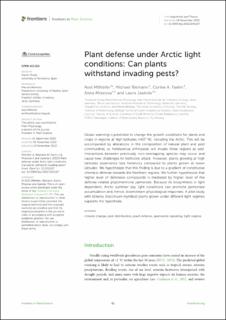| dc.contributor.author | Mithöfer, Axel | |
| dc.contributor.author | Riemann, Michael | |
| dc.contributor.author | Faehn, Corine Alexis | |
| dc.contributor.author | Mrazova, Anna | |
| dc.contributor.author | Jaakola, Laura | |
| dc.date.accessioned | 2023-03-14T13:05:37Z | |
| dc.date.available | 2023-03-14T13:05:37Z | |
| dc.date.created | 2022-12-16T17:25:34Z | |
| dc.date.issued | 2022-11-24 | |
| dc.identifier.citation | Frontiers in Plant Science. 2022, 13 . | en_US |
| dc.identifier.issn | 1664-462X | |
| dc.identifier.uri | https://hdl.handle.net/11250/3058184 | |
| dc.description.abstract | Global warming is predicted to change the growth conditions for plants and crops in regions at high latitudes (>60° N), including the Arctic. This will be accompanied by alterations in the composition of natural plant and pest communities, as herbivorous arthropods will invade these regions as well. Interactions between previously non-overlapping species may occur and cause new challenges to herbivore attack. However, plants growing at high latitudes experience less herbivory compared to plants grown at lower latitudes. We hypothesize that this finding is due to a gradient of constitutive chemical defense towards the Northern regions. We further hypothesize that higher level of defensive compounds is mediated by higher level of the defense-related phytohormone jasmonate. Because its biosynthesis is light dependent, Arctic summer day light conditions can promote jasmonate accumulation and, hence, downstream physiological responses. A pilot study with bilberry (Vaccinium myrtillus) plants grown under different light regimes supports the hypothesis. | en_US |
| dc.language.iso | eng | en_US |
| dc.publisher | Frontiers Media | en_US |
| dc.rights | Navngivelse 4.0 Internasjonal | * |
| dc.rights.uri | http://creativecommons.org/licenses/by/4.0/deed.no | * |
| dc.title | Plant defense under Arctic light conditions: Can plants withstand invading pests? | en_US |
| dc.title.alternative | Plant defense under Arctic light conditions: Can plants withstand invading pests? | en_US |
| dc.type | Peer reviewed | en_US |
| dc.type | Journal article | en_US |
| dc.description.version | publishedVersion | en_US |
| dc.rights.holder | © 2022 Mithöfer, Riemann, Faehn, Mrazova and Jaakola | en_US |
| dc.source.pagenumber | 10 | en_US |
| dc.source.volume | 13 | en_US |
| dc.source.journal | Frontiers in Plant Science | en_US |
| dc.identifier.doi | 10.3389/fpls.2022.1051107 | |
| dc.identifier.cristin | 2094618 | |
| dc.source.articlenumber | 1051107 | en_US |
| cristin.ispublished | true | |
| cristin.fulltext | original | |
| cristin.qualitycode | 2 | |

